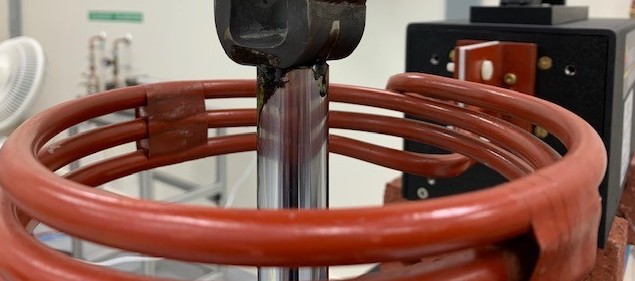Curing Material on an Aluminum Mandrel
Objective Heat a customer supplied aluminum cylinder to 80-120°C for a material curing application. More application notes
Processes
Processes: More
Processes: More

Industries:
Industries: More
Industries: More
Industries: More

Products:
Products: More
Services:
Services: More

Learn:
Learn: More
About:


An organization from the automotive industry had been using torch heating for their steel rod assembly preheating process. However, due to process improvements thanks to new automation in their facility, torch heating became too slow. This resulted in a backlog that kept them from maximizing throughput. So they turned to THE LAB at Ambrell to see if induction heating could resolve this issue.
THE LAB determined that an Ambrell EKOHEAT® 10 kW, 50-150 kHz induction heating system would be the right system for their requirements. Temperature indicating paint was applied to the part, which dissolves when the part reaches the target temperature. It took 45 to 75 seconds to heat each part to temperature, depending on part size. These results exceeded the client's requirements and enabled the client to enjoy improved throughput and fully realize the efficiency gains from their investment in automation.
Induction heating offers several benefits compared to torch heating. As already mentioned, speed can be one factor, which can boost throughput in a manufacturing process. Additionally, precision and repeatability are considerable benefits, as induction delivers consistent results every time. Finally, eliminating an open flame in the work environment improves workplace safety while also introducing less heat into the work environment.
To read other application notes from THE LAB at Ambrell, visit our heating applications page.

Objective Heat a customer supplied aluminum cylinder to 80-120°C for a material curing application. More application notes

In today’s manufacturing landscape, efficiency, precision, and sustainability are critical. Induction heating—a process that uses electromagnetic...

When it comes to many manufacturing processes, including this forging application, precision and efficiency are critical. Traditional heating methods...